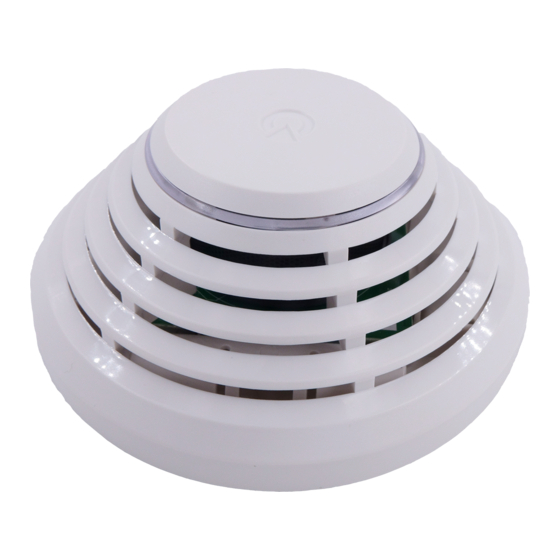
Advertisement
Quick Links
The JA-110ST Bus combined smoke and heat fire detector
The JA-110ST is a component of the JABLOTRON JA-100 system.
It is used to detect fire hazards in a building interior. The product is not
designed to be installed in industrial premises. The JA-110ST consists
of an optical smoke detector and a heat detector. The optical smoke
detector is very sensitive to large dust particles which are present in
dense smoke. It is less sensitive to smaller particles generated by the
combustion of liquids such as alcohol. That is why the fire detector also
contains a built-in heat detector which has a slower reaction but is
much better at detecting fire which generates only a small amount of
smoke. The detector has a status reaction (reports its activation and
deactivation). The detector should be installed by a trained technician
with a valid certificate issued by an authorized distributor.
Detector location
The smoke detector must be installed so that any smoke easily drifts
into the detector owing to natural thermal currents (usually on the
ceiling). The detector can only be used in enclosed interiors. It is not
suitable for interiors where smoke can disperse over a large area and
cool down (e.g. interiors with extremely high ceilings – above 5 m) – the
smoke would not reach the detector position.
The detector must always be placed in the section leading to the exit
of the building (escape route), see Figure 1. If the building has a floor
2
area greater than 150 m
, installation of an additional detector in some
other suitable place is required, see Fig.2.
1
2
Fig 1
3
1
2
6
Fig 2
6
1
3
2
Fig 3
It is recommended to place additional detectors in rooms where
people sleep.
Installation on level ceilings
Place the detector in the centre of the room if possible. The detector
must not be recessed into the ceiling due to the possible existence
of a cool air layer on the ceiling. Never place the detector in the
corner of the room (always keep at least a 0.5 m distance from the
corner) see Fig 4.
There is an insufficient circulation of air in corners.
The JA-110ST Bus combined smoke and heat fire detector
3
4
5
4
1. kitchen,
2. living room,
3. – 6.
5
bedrooms
/
basic
coverage
recommended
coverage
Installation on sloping ceilings
If the ceiling is not suitable for mounting on a level surface (e.g. a
room under a roof ridge), the detector can be installed as in Fig. 5.
TOP
Fig 4
centre of the room, best location
acceptable location
Walls, partitions, barriers and lattice ceilings
The JA-110ST detector must not be installed closer than 0.5 m
from any wall or partition. A narrow space with a width of less than
1.2m requires the detectors to be placed at a distance of at least one
third of its width away. In a case when a room is separated into
sections with furniture, racks or semi partition walls which do not reach
the ceiling, the space is considered to be fully separated if the gap
between the top of these and the ceiling does not exceed 0.3 m.
A free space of at least 0.5m is required under and around the detector.
Any irregularities of the ceiling (e.g. girders) exceeding 5 % of the
ceiling height should be considered a wall and the above-mentioned
limitations should apply.
Ventilation and air circulation
The detectors must not be installed directly by ventilation or air
conditioning vents, etc. In the case of air being supplied through a
perforated ceiling, each detector must be placed so that no perforation
hole occurs within 0.6 m of the detector.
Avoid installing the detector in the following locations:
places with poor air circulation (niches, corners, apexes of
A-shaped roofs, etc.)
places exposed to dust, cigarette smoke or steam
places with over-intense air circulation (close to ventilators, heat
sources, air conditioning outlets, etc.)
in kitchens and other cooking places (because steam, smoke or
oily fumes can cause false alarms or reduce detector sensitivity).
beside fluorescent lights or energy-saving light bulbs (electrical
interference can cause a false alarm)
in areas with lots of small insects
Warning: Most false alarms are caused by improper
detector location.
See CEN/TS 54-14 standards for detailed installation guidelines.
Installation
When
installing
the
detector,
recommended in the previous paragraphs.
1
3
Fig 6: 1– detector cover opening (removal); 2 – detector cover closing
(insertion); 3 – optical signalling; 4 – arrow showing where to insert the
detector; 5 – bus connection terminals; 6 – production code;
1.
open the detector cover, by turning it anti-clockwise
2. Insert the bus cable and attach the plastic base to the selected
place using screws.
3. Connect the bus cable.
1 / 2
0.5m
0,9 m
Fig 5
abide
by
the
procedures
2
1400- 0 0- 0000- 0001
BUS
MLW51605
4
5
6
Advertisement

Subscribe to Our Youtube Channel
Summary of Contents for jablotron JA-110ST
- Page 1 Walls, partitions, barriers and lattice ceilings cool down (e.g. interiors with extremely high ceilings – above 5 m) – the The JA-110ST detector must not be installed closer than 0.5 m smoke would not reach the detector position. from any wall or partition. A narrow space with a width of less than The detector must always be placed in the section leading to the exit 1.2m requires the detectors to be placed at a distance of at least one...
- Page 2 Means of detecting – smoke only, heat only, smoke and heat at the same time, smoke or heat. JABLOTRON ALARMS a.s. hereby declares that the JA-110ST module is in compliance with the essential requirements and other relevant provisions of Detector testing and maintenance Directive 89/106/EEC a 2004/108/EC.














Need help?
Do you have a question about the JA-110ST and is the answer not in the manual?
Questions and answers